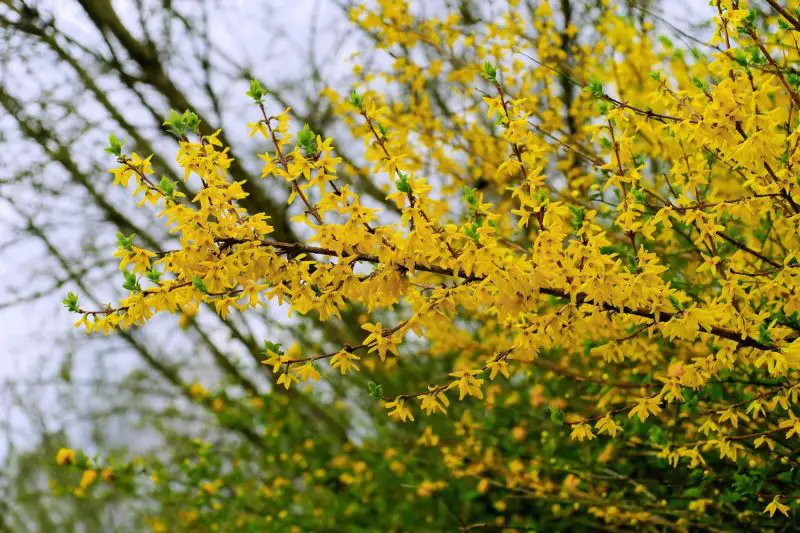Forsythia is one of the earliest signs of spring, lighting up gardens with its bright yellow flowers before most other plants awaken from winter dormancy. This fast-growing shrub is loved for its cheerful blooms, but without proper trimming, it can quickly become overgrown and lose its vibrant display. Learning the right time to trim forsythia is the key to keeping it blooming beautifully year after year.
Many gardeners mistakenly cut their forsythia at the wrong time, which can significantly reduce flower production the following spring. Because forsythia forms its flower buds on old wood, timing and technique are critical. Understanding its growth cycle and trimming it correctly ensures that each spring, your shrub bursts with thousands of brilliant yellow blossoms.

Understanding Forsythia’s Blooming Cycle
Forsythia blooms on old wood, meaning the flower buds that open in spring were formed during the previous summer. After flowering, the plant immediately begins to set buds for the following year. These buds remain dormant through fall and winter before finally blooming when temperatures rise in early spring.
This blooming cycle explains why trimming at the wrong time can drastically reduce flower production. If you prune too late in the season, you risk cutting off the buds that would bloom next year. By understanding when these buds develop, you can plan your trimming schedule to preserve as many flower buds as possible.
Forsythia also grows rapidly, often sending out long, arching canes that can quickly make the shrub look untidy. Regular trimming keeps the plant’s shape under control while encouraging new growth that supports healthier blooms.
The Best Time to Trim Forsythia
The ideal time to trim forsythia is immediately after it finishes blooming in spring. Trimming at this time allows you to shape the plant without interfering with next year’s flower buds. Because the buds for next year’s blooms will begin forming soon after flowering ends, you have only a few weeks to prune without risking flower loss.
In most regions, this timing typically falls between late March and May, depending on climate and blooming period. Waiting until summer or fall to trim will almost certainly remove the buds that would produce flowers the following spring, resulting in sparse or no blooms.
Pruning immediately after flowering also gives the plant the rest of the growing season to recover and produce new wood, which will carry the next year’s flowers. The earlier you trim after blooming, the more time the shrub has to set buds for the next season.
How Much to Trim to Encourage More Blooms
The amount you trim influences how many flowers your forsythia produces. Because this shrub flowers on old wood, heavy pruning every year is not necessary for consistent blooming. However, removing some of the older, thicker canes encourages new, healthy growth, which will eventually produce more flower buds.
For best results, cut back about one-third of the oldest, woodiest stems to the ground each year. This rejuvenates the plant and keeps it producing strong canes that support heavy flowering. Younger stems typically produce the most abundant blooms, so encouraging fresh growth ensures a fuller, brighter display.
If your forsythia has been neglected for several years and has become overgrown, a more aggressive rejuvenation pruning may be necessary. In such cases, cutting back all canes to about six inches from the ground can help renew the plant, although it may take a season or two for full flowering to return.
Proper Trimming Techniques for Healthy Growth
Trimming forsythia correctly ensures healthy regrowth and abundant flowering. Always use clean, sharp pruning shears to make smooth cuts, as ragged or torn cuts can invite disease and slow recovery. Cut stems at a slight angle to allow water to run off easily, reducing the risk of rot.
When shaping the plant, focus on removing older canes at the base rather than simply shearing the top. Shearing can lead to a dense outer layer of growth while leaving the inner branches bare, which reduces airflow and sunlight penetration. Thinning out older stems from the inside keeps the plant open, airy, and better able to produce blooms.
Directing your cuts just above a healthy outward-facing bud or branch helps guide new growth in the desired direction. Over time, this technique maintains a graceful, arching shape, which is c
Why Timing Matters for Consistent Blooms
Trimming at the right time ensures that you do not accidentally remove flower buds for the following year. Since forsythia sets its buds soon after spring flowering, cutting too late in summer or fall eliminates the developing buds and leads to reduced flowering. Many gardeners mistakenly trim in winter, only to find their shrubs bare of flowers the next spring.
Proper timing also allows the plant to recover and grow new wood before winter. Fresh wood is essential for forming healthy buds, and trimming too late gives the shrub less time to store energy for the following year’s blooms.
By consistently trimming after flowering each spring, you ensure that the plant remains productive, producing abundant flowers year after year.
Caring for Forsythia After Trimming
After trimming, proper care helps the plant recover quickly and prepare for the next blooming season. Providing adequate water, especially during dry spells, helps the plant channel energy into developing new wood and flower buds. Mulching around the base keeps soil moisture consistent and protects the roots during hot weather.
Feeding the shrub with a balanced, slow-release fertilizer in early summer can encourage healthy growth and bud formation. Avoid heavy fertilization late in the season, as it can stimulate new growth too close to winter, which may be damaged by frost.
Keeping the area around the base free from weeds and debris improves airflow and prevents competition for nutrients, giving the plant the best conditions to thrive.
Rejuvenating Old or Neglected Forsythia
If your forsythia has been neglected for years, it may produce fewer flowers and have many old, woody canes. In such cases, a rejuvenation pruning may be necessary to restore its beauty. This involves cutting all canes back to six to twelve inches from the ground in late spring after flowering.
While you may lose a season of heavy blooms following rejuvenation, the plant will produce vigorous new growth that sets the foundation for abundant flowering in future years. With proper care and annual maintenance pruning, the shrub will quickly regain its vibrant spring display.
Common Trimming Mistakes to Avoid
One of the most common mistakes is trimming at the wrong time, particularly in late summer, fall, or winter. Cutting during these times removes the buds for the next year’s flowers, leaving the shrub bare in spring.
Another mistake is shearing the shrub like a hedge, which may look neat temporarily but leads to dense outer growth and a hollow center. This reduces the number of flowering stems and can eventually weaken the plant.
Over-trimming young plants is another issue. Newly planted forsythias need time to establish their root systems before heavy pruning. Light shaping is fine, but wait at least a couple of years before starting regular maintenance trimming.
FAQs About Trimming Forsythia
When Is the Best Time to Trim Forsythia?
The best time to trim forsythia is right after it finishes blooming in spring. Pruning immediately after flowering allows the shrub to set buds for the next year.
How Much Should You Cut Back Forsythia Each Year?
Cutting back about one-third of the oldest canes to the ground each year encourages fresh growth and keeps the plant producing abundant flowers.
Can You Trim Forsythia in Winter?
Trimming in winter is not recommended because it removes the flower buds formed the previous summer, which will reduce or eliminate spring blooms.
Will Trimming Forsythia Too Late Affect Next Year’s Flowers?
Yes, trimming in late summer or fall removes developing buds, resulting in fewer or no flowers the following spring.
How Do You Rejuvenate an Old or Overgrown Forsythia?
For severely overgrown forsythia, cut all canes back to six to twelve inches from the ground after spring blooming. This encourages strong new growth for future flowers.
Conclusion
Trimming forsythia at the right time is the secret to keeping it blooming year after year. Because it flowers on old wood, pruning immediately after spring blooming preserves next year’s buds while encouraging new growth. Cutting back about one-third of the oldest canes each year rejuvenates the plant, ensuring it remains healthy, full, and covered in bright yellow flowers each spring.
With the proper timing, technique, and aftercare, your forsythia will reward you with a dazzling display season after season. A well-maintained shrub not only brightens your garden in early spring but also remains an attractive, lush green backdrop for the rest of the year.






